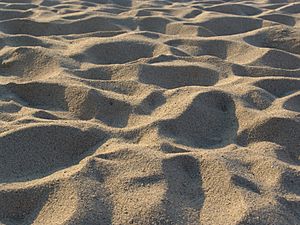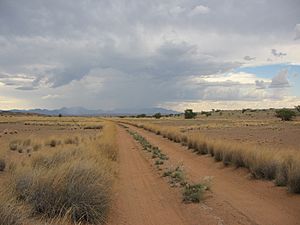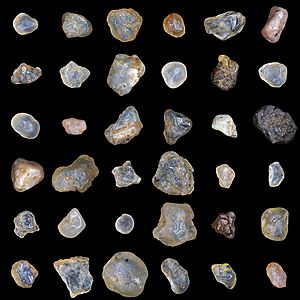Sand facts for kids

Sand is a mixture of very small pieces of different rocks or minerals. It is the same minerals from which those pieces are broken, such as granite and feldspar. Sand is gritty to touch. It is a naturally occurring granular material composed of finely divided rock and mineral particles. Sand is also formed various rocks by weathering and erosion. Erosion breaks large boulders into smaller rocks. They get smaller and smaller until they reach the beach or a low-lying area as sand.
Sand grains are between the size of gravel grains (which is from 2 mm to 64 mm) and the size of silt (which is around 0.0625 mm to 0.004 mm). Most sand is found on beaches, and in deserts. The most common sands are made of silica (silicon dioxide, or SiO2). Calcium carbonate is the second more common.
Sand dunes are made when wind or a river pulls sand into a mountain-like shape. They can be found in deserts, but sometimes high up on beaches too.
Sand is crucial in the process of mixing concrete. It can also be used to make sand castles. Sand is sometimes in households for aesthetic purposes.
Uses
- Agriculture: Sandy soils are ideal for crops such as watermelons, peaches and peanuts, and their excellent drainage characteristics make them suitable for intensive dairy farming.
- Aquaria: Sand makes a low cost aquarium base material which some believe is better than gravel for home use. It is also a necessity for saltwater reef tanks, which emulate environments composed largely of aragonite sand broken down from coral and shellfish.
- Artificial reefs: Geotextile bagged sand can serve as the foundation for new reefs.
- Artificial islands in the Persian Gulf.
- Beach nourishment: Governments move sand to beaches where tides, storms or deliberate changes to the shoreline erode the original sand.
- Brick: Manufacturing plants add sand to a mixture of clay and other materials for manufacturing bricks.
- Cob: Coarse sand makes up as much as 75% of cob.
- Concrete: Sand is often a principal component of this critical construction material.
- Glass: Sand rich in silica is the principal component in common glasses.
- Hydraulic fracturing: A drilling technique for natural gas, which uses rounded silica sand as a "proppant", a material to hold open cracks that are caused by the hydraulic fracturing process.
- Landscaping: Sand makes small hills and slopes (golf courses would be an example).
- Mortar: Sand is mixed with masonry cement or Portland cement and lime to be used in masonry construction.
- Paint: Mixing sand with paint produces a textured finish for walls and ceilings or non-slip floor surfaces.
- Railroads: Engine drivers and rail transit operators use sand to improve the traction of wheels on the rails.
- Recreation: Playing with sand is a favorite beach time activity. One of the most beloved uses of sand is to make sometimes intricate, sometimes simple structures known as sand castles. Such structures are well known for their impermanence. Sand is also used in children's play. Special play areas enclosing a significant area of sand, known as sandboxes, are common on many public playgrounds, and even at some single family homes. Sand dunes are also popular among climbers, motorcyclists and beach buggy drivers.
- Roads: Sand improves traction (and thus traffic safety) in icy or snowy conditions.
- Sand animation: Performance artists draw images in sand. Makers of animated films use the same term to describe their use of sand on frontlit or backlit glass.
- Sand casting: Casters moisten or oil molding sand, also known as foundry sand and then shape it into molds into which they pour molten material. This type of sand must be able to withstand high temperatures and pressure, allow gases to escape, have a uniform, small grain size and be non-reactive with metals.
- Sand castles: Shaping sand into castles or other miniature buildings is a popular beach activity.
- Sandbags: These protect against floods and gunfire. The inexpensive bags are easy to transport when empty, and unskilled volunteers can quickly fill them with local sand in emergencies.
- Sandblasting: Graded sand serves as an abrasive in cleaning, preparing, and polishing.
- Thermal weapon: While not in widespread use anymore, sand used to be heated and poured on invading troops in the classical and medieval time periods.
- Water filtration: Media filters use sand for filtering water.
- Wuḍūʾ: the Islamic procedure for washing parts of the body.
- Zoanthid "skeletons": Animals in this order of marine benthic cnidarians related to corals and sea anemones, incorporate sand into their mesoglea for structural strength, which they need because they lack a true skeleton.
Images for kids
-
Sand dunes in the Idehan Ubari, Libya
-
Depiction of sands: glass, dune, quartz volcanic, biogenic coral, pink coral volcanic, garnet, olivine. Samples are from the Gobi Desert, Estonia, Hawaii and the mainland United States. (1x1 cm each)
-
Heavy minerals (dark) in a quartz beach sand (Chennai, India)
-
Sand from Coral Pink Sand Dunes State Park, Utah. These are grains of quartz with a hematite coating providing the orange color.
-
Sand from Pismo Beach, California. Components are primarily quartz, chert, igneous rock, and shell fragments.
-
Close up of black volcanic sand from Perissa, Santorini, Greece
-
Scanning electron micrograph showing grains of sand
-
Pitted sand grains from the Western Desert, Egypt. Pitting is a consequence of wind transportation.
See also
 In Spanish: Arena para niños
In Spanish: Arena para niños











